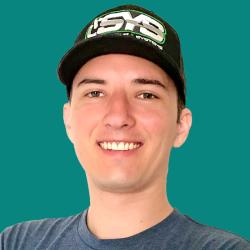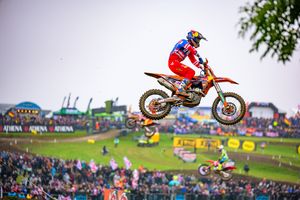In-depth with director of motorsports on current riders and developing talent for the future.
The KTM Group has two riders going for championships this weekend in Tom Vialle and RJ Hampshire, plus saw strong seasons out of reigning 450SX champion Chase Sexton and teammate Aaron Plessinger in 2024. We caught up with KTM North America director of motorsports Roger De Coster last weekend to discuss developing riders, why Sexton and Vialle eventually started riding at Bakers Factory again, and much more in this Industry feature.
We saw this year that with Aaron and RJ, they stayed at Bakers Factory and that program worked for them, but Chase and Tom chose to break away a little bit and do kind of their own program and it’s working for them as well. The first question I had about that was when you guys signed Chase and he comes to the team, what goes into making the decision that for him to do his own program is acceptable for you guys and that you can still stay on top of what he’s doing?
They didn’t break away from there, they were not there in the first place to start. Tom was used to working in Europe and he worked closely with Joel Smets. He is the guy that it seems to be important to him that he has somebody in his corner, you know, to bounce things off and Joel did a good job with him, and they won championships. Then when he came over here, he was one of a group. It was not like in Europe where everything was focused on him and so he had to get used to that. He had to get used to a completely different lifestyle and all that. He is also a rider that is measured and he’s kind of a cautious rider. So he is not a guy that is going to open the throttle wide open without knowing how to control it, you know? So that’s his style and it has worked for him. Sometimes it’s a little frustrating for us to see in practice that he’s taking his time. But this year, after being here now for the second season, he’s leading in points, so he’s doing something right. On the fitness training, he was also used to a completely different program in Europe and so he wanted to continue that way and do his own program. Aldon [Baker] has his program, and he believes in his program. He has been successful with his program with many riders.
Last year, Tom stayed basically in California and this year we pushed him and tried to have him go to Florida. Now that he had been here for a year, he had a better feel of what needs to be done and all that. At the end of last year, after the season was finished, him and Chase became friends. They rode together and practiced and all that and they became good buddies. Chase had his program and the trainer Peter [Park] in California that he believed in. He was last year’s champion, so it’s hard to say it doesn’t work. So originally, he wanted to try and train by himself, and he was at The Sandbox in Florida. The facility has a good rough track, but the other things are not so good. The competition is there also and there’s no privacy in the workspace. For a factory team, that’s difficult to have the mechanics open everything in front of your main competition. We and Austria especially, did not really like that idea. On a weekly basis, we sent things back and forth and there was none of us or Chase or Tom. None of them were there except for the time that they trained, you know? So when UPS or FedEx came and dropped parts and all that, it was not really very professional. Also, on some occasions there was a lot of people on the track, with a lot of different levels. So finally, the general feeling between Tom, Chase, and us was that they would benefit from going to Aldon’s place. Aldon had never had guys that did not do the fitness training and the physical training with him. So that was not his favorite solution, but he also realized that we have supported him for a long time, and we had a good relationship with him and that he needed to be a little bit flexible. Then we ended up with Chase and Tom training there and they ride often. The riding is basically together on the same track. Both Tom and Chase have their own discipline also about fitness training. Some riders you need to push all the time, but that’s something that they have themselves. They have the discipline and don’t have to be reminded that they have to do it.
Well, specifically with Tom what I wanted to ask was, we’ve seen 450 guys do their own programs in the past, but this seems like the 250 guys doing their own stuff this year is a little new. Even thinking of Levi [Kitchen] with Pro Circuit doing his own deal in Florida and not training with the PC guys. I know Tom’s kind of a bit of a unique situation, but is that something you foresee becoming a thing where 250 guys want the freedom a little bit more?
You know, it all depends on the person, on the rider. Like I said, some riders have that inner discipline and some need to be pushed. I think if you have that discipline, that self-drive and all that, you can do it on your own. But also, there’s a benefit of working with other good guys and seeing what they do and to be pushed by them. If you do it by yourself, you may think you’re giving it 100 percent, but you may need to do a little bit more. If you have a strong mind, you could surprise yourself on what your body can do. If you have the mental strength to push yourself and take the pain, some guys have that naturally. But there’s only a few of them.
If you look at your teams’ history in the 250 class, all of your Supercross and Pro Motocross champions on a 250 with [Ken] Roczen, [Marvin] Musquin, [Zach] Osborne, they all had MXGP experience. Now Vialle is probably going to win the title and he’s a world champion from MX2. Is it simply that already having that experience as a professional has given them a little bit of an upper hand, or is there something underlying to that where what they do in Europe almost benefits them more and then when they come here to start riding for you guys, they’re better?
It’s hard to say, you know, and there’s always exceptions. I think in general in the US, the amateur racing is usually shorter and more sprint like. And then you have to remember that the guys that come over from Europe usually are the very best from Europe. So, it’s hard to generalize, but I like to see the best riders in the world come to the US. That’s what I always pushed for since the days I was racing. I like to see the best guys in the world come together whether they’re from Australia, from Europe, Japan or whatever country. I think it’s an honor for American racing that the best guys in the world want to come here.
So do you think that’s something where you as a manufacturer can – like Daniel Blair runs the amateur program, for example – you can go to him and say, ‘This is what we’re seeing, how these guys are training and racing in Europe,’ and maybe say to him, ‘We should race more. We should do this more,’ or something like that? So that the amateurs here that you’re bringing up can have a little bit more footwork underneath them?
Yeah, one of the good things happening with the Combines, to get the young guys to have a chance to race on the same tracks that top pro guys do. I think that’s another advantage from Europe. Especially now with the EMX races on the same weekend, on the same tracks. So riding longer races on a more difficult track, more challenging track, definitely develops better riders.
Like you said, the longer motors on the tougher tracks, when you see someone like a Vialle come into your program over here, is it technique stuff as well that you noticed because he’s gotten so good at lasting for a full moto on very rough tracks, so his technique is a little bit more sound over a longer distance as well?
Yeah, I would not say that the technique from racing in Europe is the reason that they have good riders. I think Supercross develops more technique than anything else. But to do it repeatedly for the entire race, the length of the races and riding tougher tracks have definitely helped on that.
Lastly for you, you’ve been in this sport for a long time, so you’ve seen the ebb and flow of what it takes for a rider, like let’s say Julien [Beaumer] for example, to get to the top level. How much has that changed over the years? Is it an ever-moving scale or do you still feel that there’s a certain framework of success that you guys can lay out for them every single time?
We can only help the riders that have it in them. We cannot instill it in them. The riders that get to the very top, there’s something special in them already and what we can do is shorten that time to get there and help them avoid mistakes injury wise or with bad habits and things like that. I always say you cannot make a racehorse out of a donkey. You can be the best trainer in the world, the best coach in the world, but it’s not going to happen. Champions have something special and they’re willing to do whatever it takes, and usually champions are very good at listening to advice from a few people and select what fits them and apply it. So for us, for the teams, the challenge is to find and recognize the young upcoming guys that have something special.








